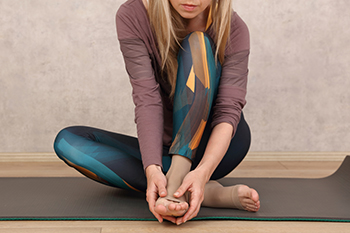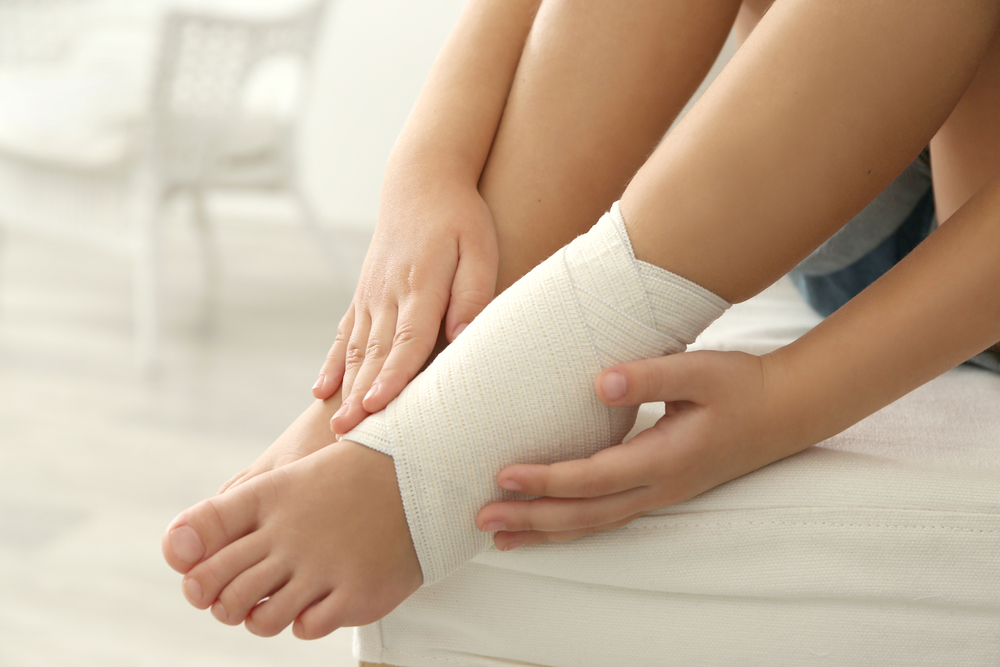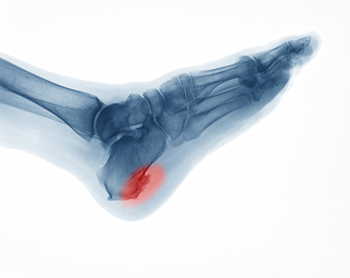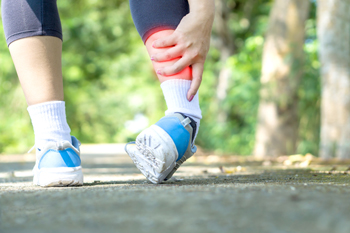Blog
What Is Blue Toe Syndrome?
Blue toe syndrome is a condition in which one or more toes develop a lace-like, bluish-purple discoloration (livedo reticularis) due to a blockage of the small blood vessels in the foot. In addition to skin discoloration, blue toe syndrome can cause intense pain in the foot that may radiate higher up into the leg. This condition is often associated with older age and other conditions that affect blood flow, such as atherosclerosis. Left untreated, blue toe syndrome can lead to skin ulceration, tissue death, and even gangrene. If you notice a sudden bluish-purple discoloration in your toes, it is suggested that you seek the care of a podiatrist as soon as possible.
While poor circulation itself isn’t a condition; it is a symptom of another underlying health condition you may have. If you have any concerns with poor circulation in your feet contact Elliot T. Udell, DPM of New York. Our doctor will treat your foot and ankle needs.
Poor Circulation in the Feet
Peripheral artery disease (PAD) can potentially lead to poor circulation in the lower extremities. PAD is a condition that causes the blood vessels and arteries to narrow. In a linked condition called atherosclerosis, the arteries stiffen up due to a buildup of plaque in the arteries and blood vessels. These two conditions can cause a decrease in the amount of blood that flows to your extremities, therefore resulting in pain.
Symptoms
Some of the most common symptoms of poor circulation are:
- Numbness
- Tingling
- Throbbing or stinging pain in limbs
- Pain
- Muscle Cramps
Treatment for poor circulation often depends on the underlying condition that causes it. Methods for treatment may include insulin for diabetes, special exercise programs, surgery for varicose veins, or compression socks for swollen legs.
As always, see a podiatrist as he or she will assist in finding a regimen that suits you. A podiatrist can also prescribe you any needed medication.
If you have any questions, please feel free to contact our office located in Hicksville, NY . We offer the newest diagnostic and treatment technologies for all your foot care needs.
Wounds That Don't Heal Need to Be Checked
What Types of Exercises Should I Do for a Sprained Ankle?
Following an ankle sprain, doing gentle ankle exercises can be beneficial, although you should first get your doctor’s approval. Ankle exercises are great for ankle sprain recovery because they can improve your ankle’s range of motion, strength, stability, and flexibility, which can promote healing and help prevent future injuries. One simple exercise that you can do to improve your ankle’s range of motion is the “ankle alphabet.” Sit on a chair or couch with your leg extended out in front of you. Trace the letters of the alphabet, from A to Z, in the air using your big toe. Repeat this exercise two to three times. To learn more about the benefits of ankle exercises for ankle sprain recovery, please consult with a podiatrist.
Ankle sprains are common but need immediate attention. If you need your feet checked, contact Elliot T. Udell, DPM from New York. Our doctor can provide the care you need to keep you pain-free and on your feet.
How Does an Ankle Sprain Occur?
Ankle sprains take place when the ligaments in your ankle are torn or stretched beyond their limits. There are multiple ways that the ankle can become injured, including twisting or rolling over onto your ankle, putting undue stress on it, or causing trauma to the ankle itself.
What Are the Symptoms?
- Mild to moderate bruising
- Limited mobility
- Swelling
- Discoloration of the skin (depending on severity)
Preventing a Sprain
- Wearing appropriate shoes for the occasion
- Stretching before exercises and sports
- Knowing your limits
Treatment of a Sprain
Treatment of a sprain depends on the severity. Many times, people are told to rest and remain off their feet completely, while others are given an air cast. If the sprain is very severe, surgery may be required.
If you have suffered an ankle sprain previously, you may want to consider additional support such as a brace and regular exercises to strengthen the ankle.
If you have any questions please feel free to contact our office located in Hicksville, NY . We offer the newest diagnostic and treatment technologies for all your foot and ankle needs.
What Is a Gait Analysis?
A gait analysis is a method used to identify abnormalities in your walking or running pattern. This is a useful tool, especially for runners. Many people are afflicted with muscle imbalances, overpronated gaits, or other biomechanical issues that can make foot and ankle injuries more likely to occur while running. There are several types of gait analyses. An observational gait analysis involves a physical examination of your feet followed by a visual assessment of your gait. Following this, it should be easier to know what types of running shoes, orthotics, or other support you may need to correct any biomechanical problems. Other types of gait analyses may also measure force on your feet. To learn more about gait analyses, please consult with a podiatrist.
If you have any concerns about your feet, contact Elliot T. Udell, DPM from New York. Our doctor can provide the care you need to keep you pain-free and on your feet.
Biomechanics in Podiatry
Podiatric biomechanics is a particular sector of specialty podiatry with licensed practitioners who are trained to diagnose and treat conditions affecting the foot, ankle and lower leg. Biomechanics deals with the forces that act against the body, causing an interference with the biological structures. It focuses on the movement of the ankle, the foot and the forces that interact with them.
A History of Biomechanics
- Biomechanics dates back to the BC era in Egypt where evidence of professional foot care has been recorded.
- In 1974, biomechanics gained a higher profile from the studies of Merton Root, who claimed that by changing or controlling the forces between the ankle and the foot, corrections or conditions could be implemented to gain strength and coordination in the area.
Modern technological improvements are based on past theories and therapeutic processes that provide a better understanding of podiatric concepts for biomechanics. Computers can provide accurate information about the forces and patterns of the feet and lower legs.
Understanding biomechanics of the feet can help improve and eliminate pain, stopping further stress to the foot.
If you have any questions please feel free to contact our office located in Hicksville, NY . We offer the newest diagnostic and treatment technologies for all your foot and ankle needs.
Fracture of the Pinky Toe
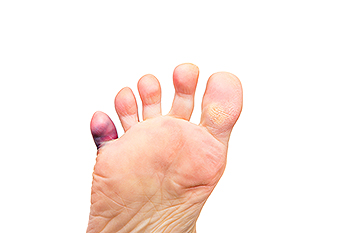 The pinky toe is the smallest toe on the foot, and it is located on the outside of the foot. It can easily be involved in an injury and be painful to deal with when broken. A broken pinky toe will often appear to be bruised, and can turn red and purple. Some patients experience swelling, as well as misalignment of the affected toe. An effective diagnosis may involve undergoing an X-ray, which can help to determine what type of fracture it is. A hairline fracture can be treated by resting the affected foot, and relief may be found when an elastic bandage is worn. Patients who are over sixty-five may be prone to enduring a dislocated toe, meaning separation of the bones in the toe. If you feel you may have broken your toe, it is strongly suggested that you are under the care of a podiatrist who can help you with correct treatment options.
The pinky toe is the smallest toe on the foot, and it is located on the outside of the foot. It can easily be involved in an injury and be painful to deal with when broken. A broken pinky toe will often appear to be bruised, and can turn red and purple. Some patients experience swelling, as well as misalignment of the affected toe. An effective diagnosis may involve undergoing an X-ray, which can help to determine what type of fracture it is. A hairline fracture can be treated by resting the affected foot, and relief may be found when an elastic bandage is worn. Patients who are over sixty-five may be prone to enduring a dislocated toe, meaning separation of the bones in the toe. If you feel you may have broken your toe, it is strongly suggested that you are under the care of a podiatrist who can help you with correct treatment options.
A broken toe can be very painful and lead to complications if not properly fixed. If you have any concerns about your feet, contact Elliot T. Udell, DPM from New York. Our doctor will treat your foot and ankle needs.
What to Know About a Broken Toe
Although most people try to avoid foot trauma such as banging, stubbing, or dropping heavy objects on their feet, the unfortunate fact is that it is a common occurrence. Given the fact that toes are positioned in front of the feet, they typically sustain the brunt of such trauma. When trauma occurs to a toe, the result can be a painful break (fracture).
Symptoms of a Broken Toe
- Throbbing pain
- Swelling
- Bruising on the skin and toenail
- The inability to move the toe
- Toe appears crooked or disfigured
- Tingling or numbness in the toe
Generally, it is best to stay off of the injured toe with the affected foot elevated.
Severe toe fractures may be treated with a splint, cast, and in some cases, minor surgery. Due to its position and the pressure it endures with daily activity, future complications can occur if the big toe is not properly treated.
If you have any questions please feel free to contact our office located in Hicksville, NY . We offer the newest diagnostic and treatment technologies for all your foot and ankle needs.
What Causes Heel Spurs?
Heel spurs are pointy calcium deposits on the heel bone that develop after there is repeated inflammation at the site where ligaments or tendons attach to it. You might be asking what causes this inflammation? Strain injuries due to athletics, chronic inflammatory disorders, and arthritis that affects tendons and ligaments all can play a factor in the development of heel spurs. Heel spurs can be associated with other conditions as well. For instance, spurs on the back of the heel bone may be associated with Achilles tendonitis, and spurs on the bottom of the heel bone may be associated with plantar fasciitis. While heel spurs don’t always cause symptoms, in some cases they have been known to create tenderness and pain where the Achilles tendon attaches to the back of the heel bone, or where the plantar fascia attaches to the bottom of the heel bone. By using x-rays and other diagnostics, a podiatrist can identify the bony outgrowth and heal the underlying condition with a variety of treatments and custom orthotics.
Heel spurs can be incredibly painful and sometimes may make you unable to participate in physical activities. To get medical care for your heel spurs, contact Elliot T. Udell, DPM from New York. Our doctor will do everything possible to treat your condition.
Heels Spurs
Heel spurs are formed by calcium deposits on the back of the foot where the heel is. This can also be caused by small fragments of bone breaking off one section of the foot, attaching onto the back of the foot. Heel spurs can also be bone growth on the back of the foot and may grow in the direction of the arch of the foot.
Older individuals usually suffer from heel spurs and pain sometimes intensifies with age. One of the main condition's spurs are related to is plantar fasciitis.
Pain
The pain associated with spurs is often because of weight placed on the feet. When someone is walking, their entire weight is concentrated on the feet. Bone spurs then have the tendency to affect other bones and tissues around the foot. As the pain continues, the feet will become tender and sensitive over time.
Treatments
There are many ways to treat heel spurs. If one is suffering from heel spurs in conjunction with pain, there are several methods for healing. Medication, surgery, and herbal care are some options.
If you have any questions feel free to contact our office located in Hicksville, NY . We offer the latest in diagnostic and treatment technology to meet your needs.
Plantar Warts Can Be Treated!
What Are the Treatments for Foot Corns?
Corns are small lumps of thickened, hardened skin that occur due to friction or pressure on an area of the foot. They are most often located in between the toes, on top of the toes, or on the soles of the feet. Corns can be uncomfortable or even painful, but non-surgical treatment is usually successful. Most of these treatments work by off-loading, or taking the pressure off of, the corn. Your doctor may ask you to wear a padded corn sleeve over the corn if it is located on your toe. If the corn is located between the toes, you may be asked to wear a toe spacer between the affected toes to take pressure and friction off the corn. A corn donut, which is a padded, donut-shaped device, can be placed around the corn to off-load it. If it is associated with a large callus, your doctor can also trim the corn. If you suffer from painful foot corns, please schedule an appointment with a podiatrist near you.
If you have any concerns regarding your feet and ankles, contact Elliot T. Udell, DPM of New York. Our doctor will treat your foot and ankle needs.
Corns: What Are They? and How Do You Get Rid of Them?
Corns can be described as areas of the skin that have thickened to the point of becoming painful or irritating. They are often layers and layers of the skin that have become dry and rough, and are normally smaller than calluses.
Ways to Prevent Corns
There are many ways to get rid of painful corns such as wearing:
- Well-fitting socks
- Comfortable shoes that are not tight around your foot
- Shoes that offer support
Treating Corns
Treatment of corns involves removing the dead skin that has built up in the specific area of the foot. Consult with Our doctor to determine the best treatment option for your case of corns.
If you have any questions please feel free to contact our office located in Hicksville, NY . We offer the newest diagnostic and treatment technologies for all your foot and ankle needs.
Is My Foot Broken, or Sprained?
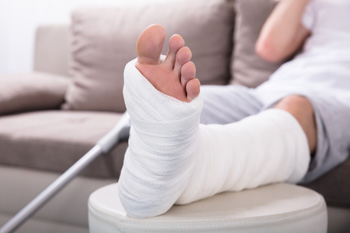 A fractured foot and a sprained foot can be difficult to tell apart as both conditions share several symptoms. A broken foot is typically more painful than a sprained foot, and the pain tends to last longer. Bruising, swelling, and tenderness are associated with both fractures and sprains, but are usually more severe in fractures. At the time of injury, you may hear a crack if there is a fracture, but a popping sound may occur if there is a sprain. Both fractures and sprains are likely to cause difficulty walking or bearing weight on the affected foot. If you have injured your foot, a podiatrist can use a combination of physical examination and imaging studies like X-rays, to determine the type of injury you have endured and which course of treatment is best for you.
A fractured foot and a sprained foot can be difficult to tell apart as both conditions share several symptoms. A broken foot is typically more painful than a sprained foot, and the pain tends to last longer. Bruising, swelling, and tenderness are associated with both fractures and sprains, but are usually more severe in fractures. At the time of injury, you may hear a crack if there is a fracture, but a popping sound may occur if there is a sprain. Both fractures and sprains are likely to cause difficulty walking or bearing weight on the affected foot. If you have injured your foot, a podiatrist can use a combination of physical examination and imaging studies like X-rays, to determine the type of injury you have endured and which course of treatment is best for you.
A broken foot requires immediate medical attention and treatment. If you need your feet checked, contact Elliot T. Udell, DPM from New York. Our doctor can provide the care you need to keep you pain-free and on your feet.
Broken Foot Causes, Symptoms, and Treatment
A broken foot is caused by one of the bones in the foot typically breaking when bended, crushed, or stretched beyond its natural capabilities. Usually the location of the fracture indicates how the break occurred, whether it was through an object, fall, or any other type of injury.
Common Symptoms of Broken Feet:
- Bruising
- Pain
- Redness
- Swelling
- Blue in color
- Numbness
- Cold
- Misshapen
- Cuts
- Deformities
Those that suspect they have a broken foot shoot seek urgent medical attention where a medical professional could diagnose the severity.
Treatment for broken bones varies depending on the cause, severity and location. Some will require the use of splints, casts or crutches while others could even involve surgery to repair the broken bones. Personal care includes the use of ice and keeping the foot stabilized and elevated.
If you have any questions please feel free to contact our office located in Hicksville, NY . We offer the newest diagnostic and treatment technologies for all your foot and ankle needs.
Gout and Diet
 Small urate crystals that can lodge in the joints of the big toe, causing severe pain, can be indicative of gout. Gout is a form of arthritis, and is caused by excess uric acid in the bloodstream. It may develop as a result of genetic factors, or from eating foods that have large amounts of purines. These types of foods can include shellfish, red meat, alcohol, and drinks that are made with sugar. Some of the symptoms that are associated with this ailment consist of pain and swelling in the big toe and surrounding area, and the condition may worsen at night. Patients who have high blood pressure, kidney disease, or who may be obese are more likely to develop gout. Relief may be felt after making positive lifestyle changes, such as dietary modifications that may consist of eating more fruits, vegetables, and drinking plenty of fresh water. If you are afflicted with gout, it is strongly suggested that you are under the care of a podiatrist who can effectively treat this condition.
Small urate crystals that can lodge in the joints of the big toe, causing severe pain, can be indicative of gout. Gout is a form of arthritis, and is caused by excess uric acid in the bloodstream. It may develop as a result of genetic factors, or from eating foods that have large amounts of purines. These types of foods can include shellfish, red meat, alcohol, and drinks that are made with sugar. Some of the symptoms that are associated with this ailment consist of pain and swelling in the big toe and surrounding area, and the condition may worsen at night. Patients who have high blood pressure, kidney disease, or who may be obese are more likely to develop gout. Relief may be felt after making positive lifestyle changes, such as dietary modifications that may consist of eating more fruits, vegetables, and drinking plenty of fresh water. If you are afflicted with gout, it is strongly suggested that you are under the care of a podiatrist who can effectively treat this condition.
Gout is a foot condition that requires certain treatment and care. If you are seeking treatment, contact Elliot T. Udell, DPM from New York. Our doctor will treat your foot and ankle needs.
What Is Gout?
Gout is a type of arthritis caused by a buildup of uric acid in the bloodstream. It often develops in the foot, especially the big toe area, although it can manifest in other parts of the body as well. Gout can make walking and standing very painful and is especially common in diabetics and the obese.
People typically get gout because of a poor diet. Genetic predisposition is also a factor. The children of parents who have had gout frequently have a chance of developing it themselves.
Gout can easily be identified by redness and inflammation of the big toe and the surrounding areas of the foot. Other symptoms include extreme fatigue, joint pain, and running high fevers. Sometimes corticosteroid drugs can be prescribed to treat gout, but the best way to combat this disease is to get more exercise and eat a better diet.
If you have any questions please feel free to contact our office located in Hicksville, NY . We offer the newest diagnostic and treatment technologies for all your foot and ankle needs.
More...
What to Do About Your Toenail Infection
 Toenail infections are very common and are caused by bacteria and fungi growing on or underneath the toenail. These fungi often thrive and grow in warm and moist environments like public pools, locker rooms and showers. Signs of a fungal nail infection include the nail thickening, turning yellow or brown, becoming crumbly, pain or the nail separating from the nail bed. Patients who notice these symptoms should consult with a podiatrist for treatment options, especially diabetic patients since the infection can lead to further complications. Upon visiting a podiatrist, they will check the nail and suggest a treatment option. Common treatment options include antifungal medications, removing the nail, or antifungal nail paints.
Toenail infections are very common and are caused by bacteria and fungi growing on or underneath the toenail. These fungi often thrive and grow in warm and moist environments like public pools, locker rooms and showers. Signs of a fungal nail infection include the nail thickening, turning yellow or brown, becoming crumbly, pain or the nail separating from the nail bed. Patients who notice these symptoms should consult with a podiatrist for treatment options, especially diabetic patients since the infection can lead to further complications. Upon visiting a podiatrist, they will check the nail and suggest a treatment option. Common treatment options include antifungal medications, removing the nail, or antifungal nail paints.
For more information about treatment, contact Elliot T. Udell, DPM of New York. Our doctor can provide the care you need to keep you pain-free and on your feet.
Toenail Fungus Treatment
Toenail fungus is a condition that affects many people and can be especially hard to get rid of. Fortunately, there are several methods to go about treating and avoiding it.
Antifungals & Deterrence
Oral antifungal medicine has been shown to be effective in many cases. It is important to consult with a podiatrist to determine the proper regiment for you, or potentially explore other options.
Applying foot powder on the feet and shoes helps keep the feet free of moisture and sweat.
Sandals or open toed shoes – Wearing these will allow air movement and help keep feet dry. They also expose your feet to light, which fungus cannot tolerate. Socks with moisture wicking material also help as well.
If you have any questions please feel free to contact our office located in Hicksville, NY . We offer the newest diagnostic tools and technology to treat your foot and ankle needs.
What Is Tenosynovitis?
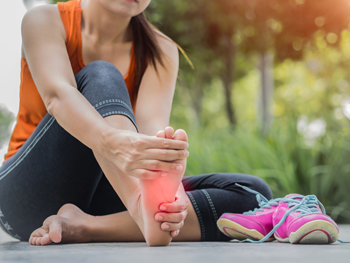 Tenosynovitis is an inflammation of a tendon and its synovium, or lining. This condition can affect the feet or ankles and occurs due to injury, repetitive overuse, excessive pressure on the tendon, or an infection. Symptoms of tenosynovitis in the lower limbs include pain, redness, or swelling, clicking, locking, or snapping in the affected foot or ankle, a grating sound or feeling, stiffness, weakness, and limited range of motion. When tenosynovitis affects the toes, there may be a noticeable bump on the toe. If you are experiencing the symptoms of this condition anywhere around your feet and ankles, it is suggested that you see a podiatrist for treatment.
Tenosynovitis is an inflammation of a tendon and its synovium, or lining. This condition can affect the feet or ankles and occurs due to injury, repetitive overuse, excessive pressure on the tendon, or an infection. Symptoms of tenosynovitis in the lower limbs include pain, redness, or swelling, clicking, locking, or snapping in the affected foot or ankle, a grating sound or feeling, stiffness, weakness, and limited range of motion. When tenosynovitis affects the toes, there may be a noticeable bump on the toe. If you are experiencing the symptoms of this condition anywhere around your feet and ankles, it is suggested that you see a podiatrist for treatment.
Ankle and foot injuries are common among athletes and in many sports. They can be caused by several problems and may be potentially serious. If you are feeling pain or think you were injured in a sporting event or when exercising, consult with Elliot T. Udell, DPM from New York. Our doctor will assess your condition and provide you with quality foot and ankle treatment.
Common Injuries
The most common injuries that occur in sporting activities include:
- Achilles Tendonitis
- Achilles Tendon Rupture
- Ankle Sprains
- Broken Foot
- Plantar Fasciitis
- Stress Fractures
- Turf Toe
Symptoms
Symptoms vary depending upon the injury and in some cases, there may be no symptoms at all. However, in most cases, some form of symptom is experienced. Pain, aching, burning, bruising, tenderness, tightness or stiffness, sensation loss, difficulty moving, and swelling are the most common symptoms.
Treatment
Just as symptoms vary depending upon the injury, so do treatment options. A common treatment method is known as the RICE method. This method involves rest, applying ice, compression and elevating the afflicted foot or ankle. If the injury appears to be more serious, surgery might be required, such as arthroscopic or reconstructive surgery. Lastly, rehabilitation or therapy might be needed to gain full functionality in the afflicted area. Any discomfort experienced by an athlete must be evaluated by a licensed, reputable medical professional.
If you have any questions, please feel free to contact our office located in Hicksville, NY . We offer the newest diagnostic and treatment technologies for all your foot care needs.
Arthritis Can Cause Pain in the Feet and Ankles
Practical Tips for Preventing Running Injuries
As a runner, taking good care of your feet can help you perform at peak levels while reducing your risks of injury. First and foremost, choose the right running shoes. Get fitted by a professional, and take into consideration your style of running, fitness goals, and the type of terrain you’ll be running on. Get your feet used to new shoes by wearing them around the house first. Wear moisture-wicking socks to keep feet dry and to avoid athlete’s foot and blisters—which can also be prevented by applying petroleum jelly or body glide on areas of friction. Reduce swelling and help your feet and muscles recover by icing and massaging your feet. Keep your toenails trimmed at the right length and straight across to avoid bruised or ingrown toenails. Do strengthening exercises to build up muscles in your feet. For more tips on avoiding running injuries, strengthening foot muscles, and choosing the right shoe for your feet, consult with a podiatrist.
All runners should take extra precaution when trying to avoid injury. If you have any concerns about your feet, contact Elliot T. Udell, DPM of New York. Our doctor will treat your foot and ankle needs.
How to Prevent Running Injuries
There are a lot of mistakes a runner can make prior to a workout that can induce injury. A lot of athletes tend to overstretch before running, instead of saving those workouts for a post-run routine. Deep lunges and hand-to-toe hamstring pulls should be performed after a workout instead of during a warmup. Another common mistake is jumping into an intense routine before your body is physically prepared for it. You should try to ease your way into long-distance running instead of forcing yourself to rush into it.
More Tips for Preventing Injury
- Incorporate Strength Training into Workouts - This will help improve the body’s overall athleticism
- Improve and Maintain Your Flexibility – Stretching everyday will help improve overall performance
- “Warm Up” Before Running and “Cool Down” Afterward – A warm up of 5-10 minutes helps get rid of lactic acid in the muscles and prevents delayed muscle soreness
- Cross-Training is Crucial
- Wear Proper Running Shoes
- Have a Formal Gait Analysis – Poor biomechanics can easily cause injury
If you have any questions, please feel free to contact our office located in Hicksville, NY . We offer the newest diagnostic and treatment technologies for all your foot care needs.
